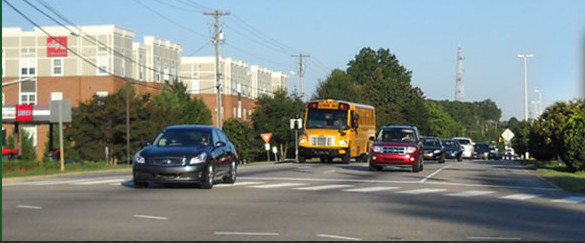The City of Raleigh and North Carolina State University are looking for ways to make Western Boulevard more pedestrian friendly.
A workshop to gather student and community feedback will take place Nov. 8.
The Capital Area Metropolitan Planning Organization is conducting a Multi-Modal Crossing Study Western Boulevard. The study is in the information-gathering stage, collecting pedestrian and vehicular data on Western Boulevard from Pullen Road east.
Related: Check out CAMPO’s zoomable Western Boulevard map with information on each section of the study area.
Western Boulevard is one of the major roadways into downtown Raleigh, according to project manager Gerald Daniel Sr. of CAMPO.
He said since the Hillsborough Street renovation, some of that traffic has redirected to Western Boulevard through N.C. State’s campus.
The road bisects N.C. State’s Centennial Campus and the main campus, with student movement across the busy road at all times of day. Daniel said the study is not in direct response to any injuries or deaths, but said city and campus officials want to be proactive.
“Of course, from the City of Raleigh’s perspective, there’s a need to address vehicular capacity while also making it a safe corridor for bicyclists and pedestrians,” he said.
A public input meeting will take place at the Sankofa Room at North Carolina State University’s Witherspoon Student Center with drop-in hours from 11 a.m. to 1 p.m.
Learn more about the study at http://westernblvd.net/.
For now, Daniel said, there are no concrete plans in place and hearing from students and residents of the area will help guide the study.
“The study will eventually lead to some kind of recommendation,” Daniel said. “But we’re currently in the data collection phase still, and at the first public workshop we hope to release some of the information we’ve collected up to this point.”
The Need for Change
Brian O’Sullivan of the N.C. State Transportation Planning office said they approached CAMPO about a year and a half ago asking for a study on the Western Boulevard section of campus.
“We’ve looked at the pedestrian crossing issue and, indirectly, at the bicycle crossing issue a number of years ago, going almost three years back,” O’Sullivan said. “It’s been a constant thorn in our side. There’s a lot of jaywalking that occurs across Western Boulevard, speeds across Western Boulevard are pretty high and I just think that we are trying to come up with a better way.”
O’Sullivan said that the pedestrians are almost all students.
According to Daniel, the State Department of Transportation has previously found that most cars using Western Boulevard are through-traffic, terminating either in Downtown Raleigh or outside of town. This produces a dicey mix of cars traveling at traditional rush hours as well as peak times created by student movement according to class schedules.
“The project is trying to connect with as many student walkers, bikers or travelers in general that cross Western Boulevard between Varsity and Pullen Road as possible,” said O’Sullivan. “And this is an opportunity right in the core of campus to have some common event and try to pull people in to try and get their feedback on what their observations are, issues, opinions, maybe solutions and to fly a couple of options for improving the situation there in front of a group of students.”
[media-credit name=”Photo by CAMPO.” align=”aligncenter” width=”585″] [/media-credit]
[/media-credit]
Some Solutions
O’Sullivan said anyone is welcome at the workshop, but that they have been reaching out primarily to students. The meeting will take place at the Sankofa Room at North Carolina State University’s Witherspoon Student Center with drop-in hours from 11 a.m. to 1 p.m.
“My interest is in forging ahead and trying to identify, not a pipe dream in the sky as a solution, but what can be done in the short term? What can be done in the medium term? What can be done in the long term?” he said. “And whatever is proposed still remains an unfunded project and because the intersection is really not owned by NC State, we don’t control anything that happens there around the intersection.”
Some of the solutions discussed have been ways to physically separate the pedestrian population from the transit population. A pedestrian bridge, or an overpass to direct Western Boulevard pedestrians over Avent Ferry has come up, but the study will wait on both on the complete data and feedback from the public.
“It would have to be a joint effort with the Department of Transportation, the State, the City, to find a way to fund some level of investment to segregate pedestrians and bicyclists, if that’s the final recommendation,” O’Sullivan said. “There are a lot of players in the project; we’re just one of them.”
The study is funded primarily through CAMPO. The organization directs federal funding towards city planning projects for an 80 percent match to the city or municipality’s 20 percent. The total cost for the study is estimated to be around $125,000, carried out by contractor Stantec, a professional design and consulting firm based in Raleigh.
